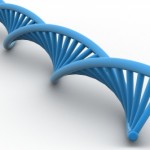 One can think of genes in a number of ways:
One can think of genes in a number of ways:
- At the level of the DNA – simply as a linear sequence of nucleotides, in ONE fixed order, in the “normal” state, or
- Again as a DNA molecule, but remember that genes in organisms, rather than in pieces of DNA in a test-tube, are subject to variation in different individuals, or
- The third way is to metaphorically zoom out and think about genes from the point of view of the whole organism and variations in those genes giving rise to variations in phenotypes. Variations in phenotype are the stuff of Darwin, the raw material on which natural selection works.
I wrote previously about a small mouse (jargon name – Del(13)36H) that had lost some of it’s genes and that this loss was associated with a quite complicated phenotype, described in our paper and similar in some ways to people that had also lost a chunk of genes.
When we first studied this mouse, one of our stumbling blocks was that we knew about only a few of the genes that had been deleted – we were in the early stages of the genome sequencing revolution, when only bits of the mouse (and human) genomes had been sequenced and genes mapped out. This was important because we wanted to be able to cross-compare mouse and human phenotypes and in order to do this, we needed to know whether the genes lost in the mouse had equivalents in humans and vice-versa.
So, the challenge we faced was to find those missing genes. There was an ongoing philosophical and technical argument about the best way to find genes by DNA sequencing, that can be divided into two camps – the Mappers and the Improvisers. The Mappers took a Map First, Sequence Later approach and the Improvisers preferred to Sequence First, Map to Check Sequence Later.
We fell into the first camp – so our first job was to build a map across the region deleted in our small mouse. But how do you build a map of an “invisible” landscape?
Obviously, by asking what is present in normal mice and absent in our small mice – this was made more difficult because mice that had inherited deleted chromosomes from both parents did not survive much beyond implantation. We had to build maps using mice that either had one or two copies of the relevant genes rather than the simpler situation of two copies or none. It may come as a surprise that it is more difficult to answer the question – do we have one or two rather than two or none? Nevertheless, we built a map, and despite what I wrote above, we sequenced parts of the map as we went along, rather than wait until we had the complete contours of the landscape determined. So, we were mapping parts of the landscape and once we were confident of that part, sending it off for sequencing. As soon as the DNA sequences were returned, the genes buried in the sequence were uncovered and slowly, a complete gene map was stitched together. We routinely followed up automated gene “annotations” with manual inspection and error-checking, which we believed supplied a Gold Standard gene map.
So what did we find?
Well, it turned out that 236 genes were deleted in our small mouse, plus also 95 “pseudogenes” – genes with uncertain functions – either they are unimportant to the living mouse but perhaps act as material for evolutionary selection or they may regulate other genes? Of the genes that we could recognise, one of the most noticeable things was that there were several clusters of genes which showed high levels of similarity to one another – they belonged to gene families. When we compared these gene families to their human equivalents, the main surprise was that the size of the family could be very different. One family of three genes encoding proteins involved in switching other genes on and off (gene regulation) was almost identical in mouse and human – whereas another family, making proteins that interact with pheromones involved in mate choice, was five times larger in number in mice than in humans. Indeed, the human pheromone interaction genes appeared non-functional; they were “pseudogenes”. Perhaps we should not be so surprised by this when we think about the differences in mating behaviour between mice and humans…
The overall theme that emerged is of polarisation – the deleted region contains genes that are very similar to human genes and others that may not have functional human equivalents. But to truly make sense of the list of genes deleted in our small mouse and it’s relevance to human phenotypes or pathology, we need to understand what those genes actually do?
And that is a story for another day. Tweet to @pauldennyuk

One Trackback
[...] Publications « Some of our genes are missing…but which ones? [...]